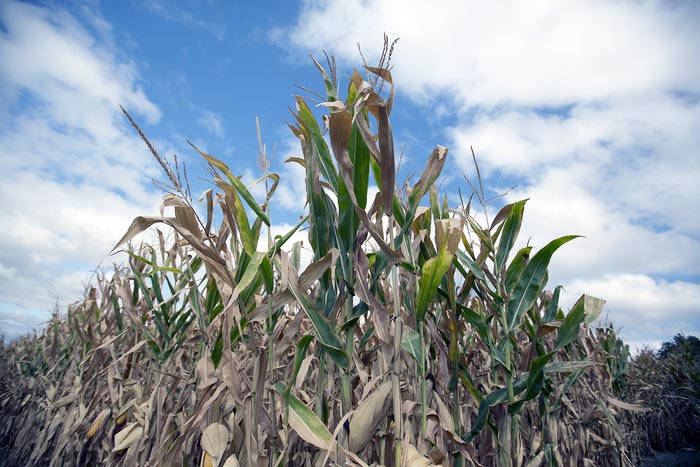‘Flash droughts’ coming on faster, global study shows

Dry corn stalks in Iowa during the flash drought of summer 2012, which wiped out crops and caused $35.7 billion in losses.
Credit: Unite States Department of Agriculture
Just like flash floods, flash droughts come on fast — drying out soil in a matter of days to weeks. These events can wipe out crops and cause huge economic losses. And according to scientists, the speed at which they dry out the landscape has increased.
Researchers at The University of Texas at Austin, The Hong Kong Polytechnic University and Texas Tech University found that although the number of flash droughts has remained stable during the past two decades, more of them are coming on faster. Globally, the flash droughts that come on the fastest — sending areas into drought conditions within just five days — have increased by about 3%-19%. And in places that are especially prone to flash droughts — such as South Asia, Southeast Asia and central North America — that increase is about 22%-59%.
Rising global temperatures are probably behind the faster onset, said co-author and UT Jackson School Professor Zong-Liang Yang, who added that the study’s results underscore the importance of understanding flash droughts and preparing for their effects.
“Every year, we are seeing record-breaking warming episodes, and that is a good precursor to these flash droughts,” he said. “The hope and purpose [of this research] is to minimize the detrimental effects.”
The research was published in Nature Communications. The study was led by doctoral student Yamin Qing and Professor Shuo Wang, both of The Hong Kong Polytechnic University.
Flash droughts are relatively new to science, with the advancement of remote sensing technology during the past couple of decades helping reveal instances of soil rapidly drying out. This serves as the telltale sign of the onset of a flash drought and can make drought conditions appear seemingly out of the blue.
As the name suggests, flash droughts are short lived, usually lasting only a few weeks or months. But when they occur during critical growing periods, they can cause disasters. For example, in the summer of 2012, a flash drought in the central United States caused the corn crop to wither, leading to an estimated $35.7 billion in losses.
In this study, the scientists analyzed global hydroclimate data sets that use satellite soil moisture measurements to capture a global picture of flash drought and how it has changed during the past 21 years. The data showed that about 34%-46% of flash droughts came on in about five days. The rest emerge within a month, with more than 70% developing in half a month or less.
When they examined the droughts over time, they noticed the flash droughts happening more quickly.
The study also revealed the importance of humidity and variable weather patterns, with flash droughts becoming more likely when there’s a shift from humid to arid conditions. That makes regions that undergo seasonal swings in humidity — such as Southeast Asia, the Amazon Basin, and the East Coast and Gulf Coast of the United States — flash drought hot spots.
“We should pay close attention to the vulnerable regions with a high probability of concurrent soil drought and atmospheric aridity,” said Wang.
Mark Svoboda, the director of the National Drought Mitigation Center and originator of the term “flash drought,” said the advancement in drought-detecting technology and modeling tools — such as those used in this study — has led to growing awareness of the influence and impact of flash droughts. He said the next big step is translating this knowledge into on-the-ground planning.
“You can go back and watch that drought evolve in 2012 and then compare it to how that tool did,” said Svoboda, who was not part of the study. “We really have the stage well set to do a better job of tracking these droughts.”
The study was funded by the National Natural Science Foundation of China and the Hong Kong Research Grants Council.
DOI: 10.1038/s41467-022-28752-4
Article Title: Accelerating flash droughts induced by the joint influence of soil moisture depletion and atmospheric aridity
Article Publication Date: 3-Apr-2022
Media Contact
Monica Kortsha
University of Texas at Austin
mkortsha@jsg.utexas.edu
Office: 512-471-2241
All latest news from the category: Studies and Analyses
innovations-report maintains a wealth of in-depth studies and analyses from a variety of subject areas including business and finance, medicine and pharmacology, ecology and the environment, energy, communications and media, transportation, work, family and leisure.
Newest articles

Innovative 3D printed scaffolds offer new hope for bone healing
Researchers at the Institute for Bioengineering of Catalonia have developed novel 3D printed PLA-CaP scaffolds that promote blood vessel formation, ensuring better healing and regeneration of bone tissue. Bone is…

The surprising role of gut infection in Alzheimer’s disease
ASU- and Banner Alzheimer’s Institute-led study implicates link between a common virus and the disease, which travels from the gut to the brain and may be a target for antiviral…

Molecular gardening: New enzymes discovered for protein modification pruning
How deubiquitinases USP53 and USP54 cleave long polyubiquitin chains and how the former is linked to liver disease in children. Deubiquitinases (DUBs) are enzymes used by cells to trim protein…



